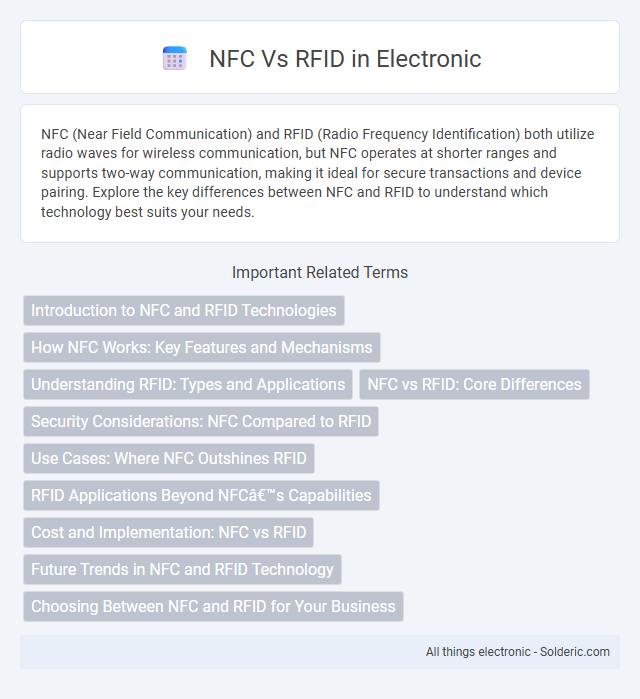NFC (Near Field Communication) and RFID (Radio Frequency Identification) both utilize radio waves for wireless communication, but NFC operates at shorter ranges and supports two-way communication, making it ideal for secure transactions and device pairing. Explore the key differences between NFC and RFID to understand which technology best suits your needs.
Comparison Table
| Feature | NFC (Near Field Communication) | RFID (Radio Frequency Identification) |
|---|---|---|
| Operating Frequency | 13.56 MHz (High Frequency) | Low (125-134 kHz), High (13.56 MHz), Ultra-High (860-960 MHz) |
| Communication Range | Up to 10 cm | Up to 100 meters (depending on type) |
| Data Transfer Speed | 106-424 kbps | Up to 640 kbps |
| Communication Type | Two-way (peer-to-peer) | Typically one-way (reader to tag) |
| Power Source | Passive, powered by reader's field | Passive, semi-passive, or active |
| Typical Applications | Contactless payments, access control, data exchange between devices | Inventory tracking, asset management, animal tracking, access control |
| Security Features | Built-in encryption and secure element support | Varies, often limited security depending on tag type |
| Cost | Moderate | Low to high, depending on tag complexity |
| Standardization | ISO 14443, ISO 18092 | ISO 18000 series |
Introduction to NFC and RFID Technologies
NFC (Near Field Communication) and RFID (Radio Frequency Identification) are wireless communication technologies used for short-range data exchange. NFC operates within a 10 cm range, enabling secure, two-way interactions in applications like contactless payments and access control, while RFID typically covers longer distances for inventory tracking and asset management. Both rely on electromagnetic fields, but NFC's standards ensure compatibility across devices, enhancing user convenience and interoperability.
How NFC Works: Key Features and Mechanisms
NFC operates through electromagnetic fields that enable two-way communication between compatible devices within a short range, typically up to 4 centimeters. Key features include secure data exchange, easy pairing without physical contact, and low power consumption, making it ideal for Contactless payments and device authentication. Your NFC-enabled device uses inductive coupling to transfer information via radio waves, ensuring quick and convenient interactions.
Understanding RFID: Types and Applications
Radio Frequency Identification (RFID) technology comprises various types, including passive, active, and semi-active systems, each distinguished by their power sources and communication ranges. Passive RFID tags rely on reader-emitted energy and are commonly used in inventory management, access control, and retail, while active RFID tags contain their own power supply, enabling longer-range tracking in logistics and asset management. Semi-active RFID combines features of both, offering enhanced performance for applications such as vehicle tracking and environmental monitoring.
NFC vs RFID: Core Differences
NFC (Near Field Communication) operates at a frequency of 13.56 MHz with a typical range of up to 10 centimeters, enabling secure, two-way communication between devices, primarily used in contactless payments and data exchange. RFID (Radio-Frequency Identification) systems vary widely in frequency bands, including low frequency (125-134 kHz), high frequency (13.56 MHz), and ultra-high frequency (860-960 MHz), supporting longer read ranges up to several meters and predominantly used for inventory tracking and asset management. The core difference lies in NFC's focus on short-range, secure peer-to-peer interactions versus RFID's broader range and one-way data transmission capabilities optimized for identification and tracking applications.
Security Considerations: NFC Compared to RFID
NFC technology offers enhanced security features over traditional RFID systems by incorporating encryption, secure channels, and mutual authentication protocols that reduce the risk of eavesdropping and data interception. Unlike passive RFID, NFC's short communication range (typically 4 cm) limits unauthorized access, making it more suitable for secure payment systems and sensitive data exchanges. However, both technologies require proper implementation of security measures such as encrypted communication and anti-cloning techniques to effectively prevent breaches.
Use Cases: Where NFC Outshines RFID
NFC excels in secure contactless payment systems, mobile ticketing, and personal device pairing due to its short range and two-way communication capabilities, making it ideal for everyday consumer interactions. Unlike RFID, which is commonly used for inventory tracking and asset management at longer distances, NFC enables seamless smartphone integration for quick data exchange and authentication. Your ability to perform secure transactions and share information effortlessly highlights NFC's distinct advantage in personal and retail environments.
RFID Applications Beyond NFC’s Capabilities
RFID technology extends beyond NFC by enabling long-range asset tracking, inventory management, and industrial automation where NFC's short-range communication falls short. RFID systems operate at various frequency bands (low, high, ultra-high) supporting diverse applications such as supply chain logistics, livestock monitoring, and security access control. This broader frequency spectrum and longer read distances make RFID indispensable in environments requiring efficient bulk scanning and remote identification.
Cost and Implementation: NFC vs RFID
NFC technology generally incurs higher costs than traditional RFID due to its advanced capabilities like two-way communication and secure encryption, making it ideal for applications requiring data exchange and payment systems. RFID offers a more cost-effective solution for large-scale asset tracking and inventory management because of its simpler infrastructure and widespread compatibility with various tags and readers. Your choice between NFC and RFID should consider budget constraints alongside the specific implementation needs, balancing upfront investment with functionality and scalability.
Future Trends in NFC and RFID Technology
Future trends in NFC and RFID technology emphasize enhanced security protocols, increased data transfer speeds, and wider integration with IoT devices. Advances in chip miniaturization and energy efficiency will enable more seamless and ubiquitous applications across industries such as retail, healthcare, and transportation. Your ability to leverage NFC and RFID innovations will drive improved asset tracking, contactless payments, and personalized customer experiences.
Choosing Between NFC and RFID for Your Business
Choosing between NFC and RFID for your business depends on the specific application and range requirements. NFC offers secure, short-range communication ideal for contactless payments and access control, while RFID provides longer-range scanning options suited for inventory management and asset tracking. Understanding the operational environment and data transfer needs will help you select the most efficient technology for maximizing efficiency and security.
NFC vs RFID Infographic

 solderic.com
solderic.com